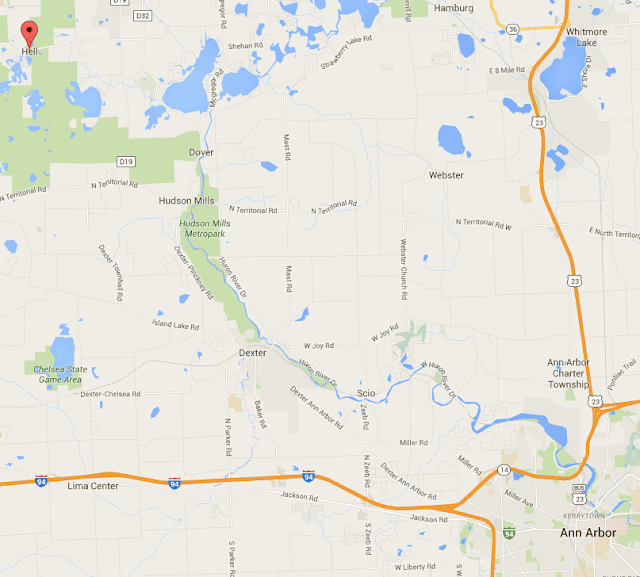The detective novel South of Hell takes place in Hell (that is, Hell, Michigan, the actual place on the map) and in Ann Arbor. I was looking for Ann Arbor restaurants in literature, and I really found them here! In fact, there were so many well-known Ann Arbor dining places that the net result seemed a bit of a cliche.
Private Investigator Louis Kincaid and detective Shockey, a member of the Ann Arbor police, who are main characters in the story, first meet at locally famous Ann Arbor greasy-spoon Krazy Jim’s, complete with its sign “Cheaper than food.” Poor Louis Kincaid is unfamiliar with Krazy’s famous eccentricities and he fails to successfully order a cheeseburger and fries: he receives only a hamburger from a spatula-wielding counter-woman, because at Krazy’s you had to ask for cheese last. Kincaid asks Shockey “Why do you come here?” When he bites into the burger, though, Louis finds that “It was delicious. Even without the cheese.” (p. 17-19)
I’ve never understood, myself, why people went there, having never been much of a fan of the greasy food or the bullying counter helpers. I don’t even know what you were required to do to get fries there. And of course the funny little building that housed this campus-area diner for generations of students has now been torn down, and Krazy’s is now at a more remote location. But this starting point means the author has established credibility as an Ann Arbor expert, I guess.
Later, after Kincaid eats his unfortunately cheeseless burger, he reflects:
“He was thinking about the woman with the spatula back at Krazy Jim’s and the look on her face when he screwed up his order, like she knew he didn’t belong there.
“How did she know?
“In his four years as a student here, he had never once set foot in Krazy Jim’s, had never gone to any of the student hangouts. No fried eggs at Angelo’s after pulling an all-nighter, no sangria at Dominick’s with a Sigma Kappa beauty, no winter-refuge pizza at the Cottage Inn, no postgame brews at the Brown Jug.
“He had never felt comfortable in those places. The only place he could remember going to more than once was the old Fleetwood Diner. There he could sit in silence with his books, watching the bums and cops just coming off shift as he sipped dark chocolate milk made to order with Hershey’s syrup. No one bothered him there. He never felt out of place there.” (p. 30)
Kincaid, as you might guess from this passage, has always felt himself to be an outsider, which evidently is because he is black. He had been accepted to Michigan Law school, but had decided to become a policeman, though he had lost his job and eventually in the book it’s clear that he can never come back to work in Michigan. The details of his prior experiences are in books 1-8 of the series, of which this is book 9.
To make sure that no famous Ann Arbor food joint is missed, eventually Kincaid eats at the Old Town bar, and on another occasion, has a hot dog and french fries at Zingerman’s deli. I think the author was in error about the fries, which I don’t recall ever seeing at Zingerman’s — and which aren’t on their current menu of potato-sides: they only offer knishes, latkes, and several types of potato salad. It makes me wonder if the authors just read some memoir of Ann Arbor student life, and never really experienced all these locally well-loved places.
Besides the characters’ experiences and memories of all the most popular Ann Arbor diners, delis, flashbacks to the farmer’s market, and a few bars and hotel dives complete with Big 10 paraphernalia, Hell also offers a brief description of the commercial establishments of Hell, MI. including the Brimstone Cafe and Devil’s Lair. Readers also get quite a lot of description of the campus and the countryside, which are a welcome distraction from the gratuitous violence and repetitive personal relationships — something like four cases of unknown fathers in one book? Puhleeze!
The Louis Kincaid books by P.J.Parrish (a pseudonym for two collaborating Detroit-born authors) are not particularly well-known as far as I can tell from googling. I wasn’t very impressed by anything in Hell except the extensive research on peak dining experiences in Ann Arbor. If I explained my distaste for the novel, I’d be giving away too much of the plot, and though my opinion of it is quite low, I won’t spoil it for anyone else. I definitely won’t be reading the eight previous novels in the series, nor any of the subsequent ones either.
I’ve definitely driven from Ann Arbor to Hell and back, and I can warn you that if you want to go there, be sure to use a map because the road signs are sure as hell stolen as soon as they are replaced. For more of my posts, including this one, see:
 |
| Google Map screen shot: from Ann Arbor to Hell, MI. |

